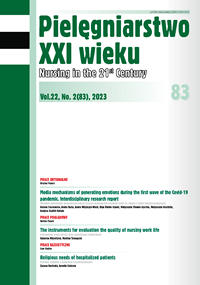Korzyści z zastosowania balonów rozszerzających pochwę w ciąży
DOI:
https://doi.org/10.2478/pielxxiw-2023-0018Słowa kluczowe:
poród, episiotomia, pęknięcie krocza, balonik rozszerzający pochwę, nietrzymanie moczuAbstrakt
KORZYŚCI Z ZASTOSOWANIA BALONÓW ROZSZERZAJĄCYCH POCHWĘ W CIĄŻY
Cel pracy. Celem pracy było określenie wpływu stosowania balonów rozszerzających pochwę w ciąży na powstanie urazów porodowych lub wycieku moczu po porodzie. Ponadto znalezienie związku między stosowaniem balonów w ciąży a trudnościami seksualnymi po porodzie.
Materiał i metody. Badaniami objęto 394 respondentki, które stosowały lub nie stosowały Aniball lub Epi/no balloon w ciąży, a czas do porodu wynosił minimum pół roku. Badanie ilościowe zostało zrealizowane za pomocą niestandaryzowanego kwestionariusza ankiety własnej konstrukcji. Badania odbywały się w gabinetach ginekologicznych oraz za pośrednictwem przeglądarek internetowych. Poszczególne zmienne zostały poddane testom statystycznym za pomocą testu Chi-kwadrat i Fishera.
Wyniki. Na podstawie badań statystycznych stwierdzono, że istnieje związek pomiędzy stosowaniem balonów rozszerzających pochwę w ciąży a powstaniem urazu poporodowego w sensie ich zmniejszenia. U kobiet, które stosowały balonik dopochwowy stwierdzono mniejszą częstość występowania problemów z nietrzymaniem moczu.
Wnioski. Na podstawie badań empirycznych stwierdzono pozytywne korzyści z zastosowania balonów dopochwowych. Pozytywne korzyści stwierdzono w związku z powstaniem urazu poporodowego i rozwojem nietrzymania moczu po porodzie.
Bibliografia
1. Howard D, Makhlouf M. Can pelvic floor dysfunction after vaginal birth be prevented. IUJ. 2016; 27(12): 1811-1815.
2. Bohatá P, Dostálek L. Antepartum options for preventing episiotomy and perineal rupture during childbirth. Czech gynecology. Prague: Czech Medical Society J.E. Purkyně. 2016; 81(3): 192-201.
3. Zanetti DRM, Petricelli DC, Alexandre MS, et al. Determination of a cutoff value for pelvic floor distensibility using the Epi-no balloon to predict perineal integrity in vaginal delivery. Sao Paulo Med. J. 2016; 134(2): 97-102.
4. Papadopoulou I. Increase in the efficiency of postpartum pelvic floor training using the EPINO trainer. TECSANA GmbH; 2020.
5. Hock M, Tardi P, Ambrus E, et al. Changes of pelvic floor muscle function during pregnancy. Studia Universitatis Babeş-Bolyai Educatio Artis Gymnasticae. 2019; 64(2): 57-68.
6. Shek KL, Dietz HP. Vaginal birth and Pelvic floor trauma. Curr. Obstet. Gynecol. Rep. 2019; 8(1): 15-25.
7. Němec M, Hořčička L, Krofta L, et al. Anatomy and biomechanics of the levator ani muscle. Czech gynecology. Prague: Czech Medical Society J.E. Purkyně. 2019; 84n(5): 393-397.
8. Vašek P, Gärtner M, Szabová O, et al. Urinary incontinence in pregnancy. Czech gynecology. Prague: Czech Medical Society J.E. Purkyně. 2019; 84(1): 73-76.
9. Freitas DeSS, Carbal LA, Pinto Costa MR, et al. Effects of perineal preparation techniques on tissue extensibility and muscle strength: a pilot study. IUJ. 2019; 30(6): 951-957.
10. Kamisan AI, Shek KL, Langer S, et al. Does the Epi-No birth trainer prevent vaginal birth-related pelvic floor trauma? A multicentre prospective randomised controlled trial. Internat. J. Gyneacol. Obstet. 2016; 123(6): 9951003.
11. Schreiner L, Crivelatti I, de Oliveira JM, et al. Systematic review of pelvic floor interventions during pregnancy. Int. J. Gynaecol. Obstet. 2018; 143(1):10-18.
12. Kubotani JS, Zanetti MRD, Araujo Júnior E, et al. Transperineal three-dimensional ultrasound for analyzing the effects of perineal stretching with EPI-NO® in women with multiple pregnancies: a pilot study. J. Matern Fetal. Neonatal. Med. 2022; 35(2): 283-290.
13. Chan SS, Cheung RYK, Yju KW, et al. Prevalence of urinary and fecal incontinence in Chinese women during and after their first pregnancy. IUJ. 2013; 24(9): 1473-1479.
14. Subki HA, Fakeeh MM, Hindi MM, et al. Fecal and Urinary Incontinence Associated with Pregnancy and Childbirth. Mater sociomed. 2019; 31(3): 202-206.
15. MacArthur C, Wislson D, Herbison P, et al. Urinary incontinence persisting after childbirth: extent, delivery history, and effects in a 12–year longitudinal cohort study. Internat. J. Gyneacol. Obstet. 2016; 123(6): 1022-1029.
16. Lawrence L, Rogers R, Borders N, et al. The effect of perineal lacerations on pelvic floor function and anatomy at six months postpartum in a prospective cohort of nulliparous women. Birth. 2016; 43(4): 293-309.
17. Quoc Huy NV, Phuc An LS, Phuong LS, Minh TL. Pelvic Floor and Sexual Dysfunction After Vaginal Birth With Episiotomy in Vietnamese Women. Sex Med. 2019; 7(4): 514-521.
Pobrania
Opublikowane
Numer
Dział
Licencja
Prawa autorskie (c) 2023 Autorzy

Utwór dostępny jest na licencji Creative Commons Uznanie autorstwa 4.0 Międzynarodowe.




